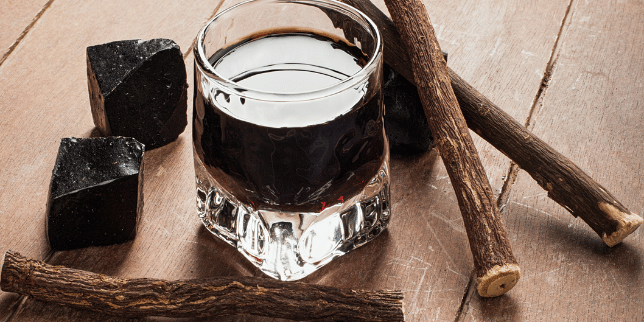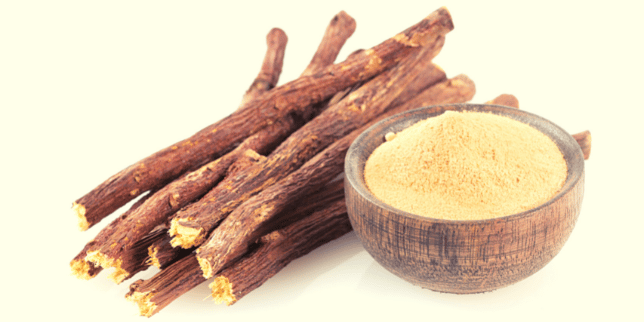Skin issues have been a common problem with every female, whether young or old. Even acne is just not limited to teenagers. It might have been decades since you have passed high school, but you can still wake up with a giant red zit on your face or whiteheads on your cheeks.
Issues like hyperpigmentation and dark spots add more woes to skin problems. However, by following and sticking to a regular skincare routine and natural solutions and home remedies, it is possible to steer clear of skin issues.
Licorice is one such natural product that treats most skin problems like hyperpigmentation, dark spots, and acne. Preparing licorice serum at home and using it with different face packs for treating these skin issues is quite simple.
This guide will first check how to prepare licorice extract at home along with the basic skincare routine to achieve clear and flawless skin.
What is Licorice Extract?

Licorice, known as Yashtimashu in Sanskrit and Mulethi in Hindi, is an ayurvedic herb that comes from the root of the licorice plant. It is the most popular herb for lightening the skin and removing dark spots.
Licorice extract is filled with beneficial compounds that work miraculously on the skin to deliver antioxidant and anti-inflammatory properties that help fade away dark spots. This is why licorice extract makes an excellent choice for most skin brightening products.
Benefits of Using Licorice Extract
- Controls excess melanin production
Licorice contains an active compound, liquiritin, that helps in dispersing and removing excessive melanin production in the skin. This not only helps to prevent forming of new spots but also helps fade away the existing ones.
- Minimizes glabridin to fight against skin discoloration
Licorice extract is a natural skin lightening remedy alternative to hydroquinone, a chemical that brightens the skin but leaves behind side effects. Licorice or mulethi contains antioxidants like licochalcone and glabridin that soothes the skin and also help fight aging problems. Glabridin slows down tyrosinase, an enzyme causing skin pigmentation due to excessive sun exposure.
- Acts as an antioxidant
Licorice contains flavonoid, which is an antioxidant component. It decreases the oxygen elements that react with the skin making it dull and discolored.
Preparing Licorice Serum at Home
- Take 4-5 medium-sized root sticks of licorice
- Boil 2 cups of water
- Add licorice roots to the boiling water
- Let the sticks boil for 10 minutes on medium flame
- Allow it to cool for at least 15 minutes
- Strain the light-yellow colored liquid
- Your licorice serum is ready.
What’s the Shelf Life of Licorice Serum?
Licorice root is an ayurvedic herb that is used in making serum. You can store the serum in an empty or spray bottle and refrigerate it for 8 to 10 days. Prepare a new portion after ten days.
Using licorice serum extract is best as it will be concentrated and contain a high amount of ingredients.
- Follow exact directions on how often and when to use it.
- Be careful of applying sunscreen when using licorice extract, as sun exposure may hamper your skin brightening efforts.
- Aside from using licorice extract, make sure you are following all healthy skincare habits to achieve maximum benefits.
How to Use Licorice Serum?
Licorice serum has lots of benefits in fading away dark spots and hyperpigmentation, and it can also be used as a spot treatment for removing scars.
1. Applying directly to the face
- Wash your face and apply the licorice serum dipped in a cotton ball or a pad
- Apply it on your face twice every day, just like the toner
- The serum dries in 2 minutes
- If the skin feels too dry, you may apply a moisturizer
- Keep the serum for 10 minutes, then wash your face
- Re-moisturize your face
2. In face packs
Licorice serum can be used in face packs also.
- Mix one tablespoon of licorice serum to any of your face packs
- Use it once or twice a week for beneficial results
Home Remedies with Licorice Powder

In addition to serum, licorice is also available in powder form that can be used as a home remedy for different skin types. It will also do wonders for your skin and give you a beautiful youthful glow. Here are some popular remedies for you to try –
Licorice with honey for normal skin
Licorice extract helps fight against pimples, blackheads, and whiteheads common in ordinary skin people.
- Mix two tablespoons of licorice powder with half a tablespoon of honey and one teaspoon of lemon juice
- Apply and wash after 25 minutes
Licorice powder and sandalwood for sensitive skin
Licorice helps fight inflammation problems in sensitive skin, and it provides a soothing effect to the skin when combined with sandalwood.
- One tablespoon of licorice powder is mixed with half a tablespoon of sandalwood powder and two tablespoons of raw milk.
- Apply a thick paste on the face and leave for 15 to 20 minutes
- Wash it off with cold water
- For maximum benefits, apply this face pack twice a week.
Licorice and orange peel powder for oily skin
Licorice with orange peel powder opens clogged pores and brightens the skin.
- Mix one tablespoon of licorice powder with one tablespoon of ground orange peel and one tablespoon of lemon juice
- Apply this pack and massage when it is wet
- Wash with water; spray rose water on the face
- Apply moisturizer.
Licorice and aloe vera for combination skin
- Mix one tablespoon of licorice powder and aloe vera pulp
- Add apple cider vinegar
- Apply this pack
- Wash after 20-25 minutes
Licorice extract is a boon for your skin as it treats a variety of skin conditions. The unique herbal remedy has the potential to undo the damage caused by the UV rays of the sun. So the next time someone puts out one of those big tubs of licorice at work, think about how effective this divisive candy is when it comes to skincare.





[…] Read: How to Make Licorice Extract For Skin at Home […]